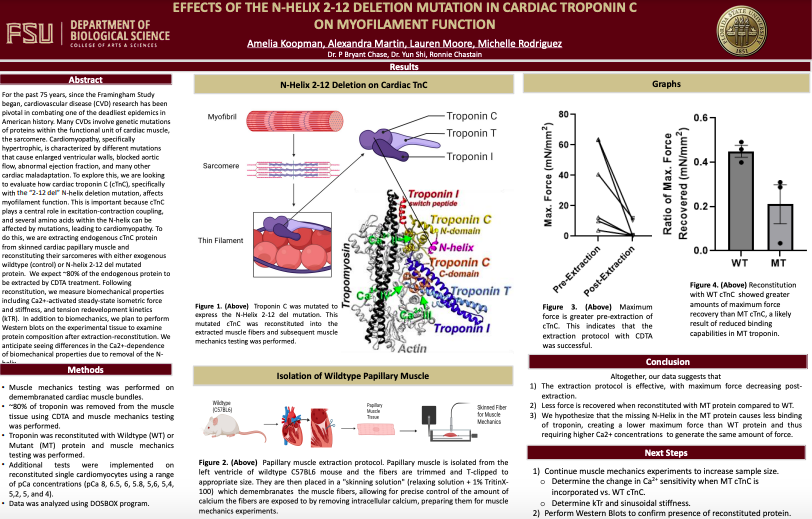Research Symposium
25th annual Undergraduate Research Symposium, April 1, 2025
Amelia Koopman Poster Session 2: 10:45 am - 11:45 am/ Poster #9
BIO
I am a third-year undergraduate student who is on a pre-PA track. I have been doing research in Dr. Chase's lab for 5 semesters now, working on a variety of projects on muscle mechanics.
Effects of the N-Helix 2-12 Deletion Mutation in Cardiac Troponin C on Myofilament Function
Authors: Amelia Koopman, Dr. P. Bryant ChaseStudent Major: Biological Science
Mentor: Dr. P. Bryant Chase
Mentor's Department: Department of Biological Science Mentor's College: College of Arts and Sciences Co-Presenters: Alexandra Martin, Lauren Moore, and Michelle Rodriguez
Abstract
For the past 75 years, since the Framingham Study began, cardiovascular disease (CVD) research has been pivotal in combating one of the deadliest epidemics in American history. Many CVDs involve genetic mutations of proteins within the functional unit of cardiac muscle, the sarcomere. Cardiomyopathy, specifically hypertrophic, is characterized by different mutations that cause enlarged ventricular walls, blocked aortic flow, abnormal ejection fraction, and many other cardiac maladaptation. To explore this, we are looking to evaluate how cardiac troponin C (cTnC), specifically with the “2-12 del” N-helix deletion mutation, affects myofilament function. This is important because cTnC plays a central role in excitation-contraction coupling, and several amino acids within the N-helix can be affected by mutations, leading to cardiomyopathy. To do this, we are extracting endogenous cTnC protein from skinned cardiac papillary muscle and reconstituting their sarcomeres with either exogenous wildtype (control) or N-helix 2-12 del mutated protein. We expect ~80% of the endogenous protein to be extracted by CDTA treatment. Following reconstitution, we measure biomechanical properties including Ca2+-activated steady-state isometric force and stiffness, and tension redevelopment kinetics (kTR). In addition to biomechanics, we plan to perform Western blots on the experimental tissue to examine protein composition after extraction-reconstitution. We anticipate seeing differences in the Ca2+-dependence of biomechanical properties due to removal of the N-helix.
Keywords: troponin, cardiomyopathy, mutation, muscle mechanics, calcium


